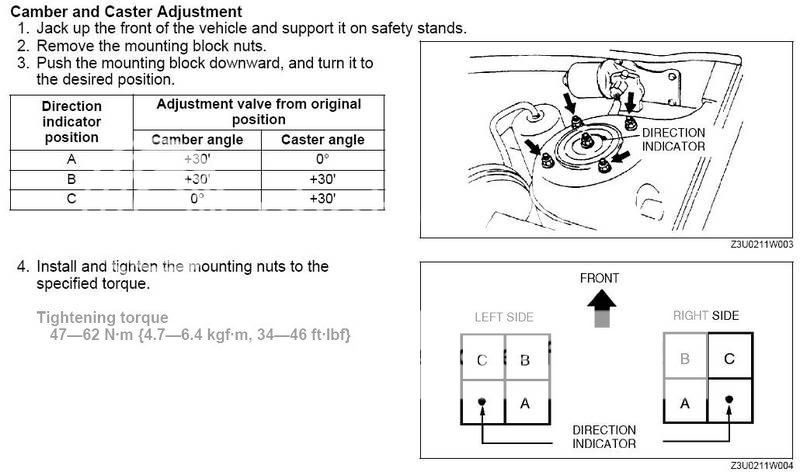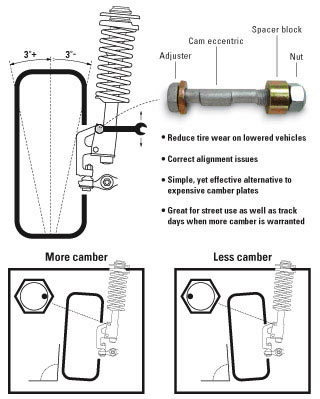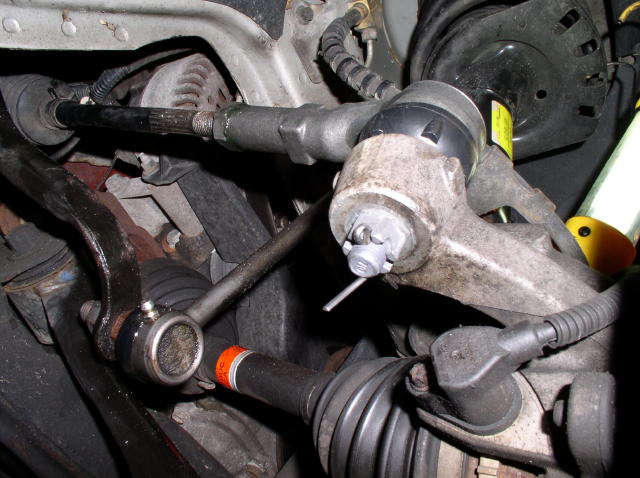- :
- aggressive auto culture
Some people were asking some questions in the stance thread, so I thought Id try and clear some stuff up. Cars are my future career and Im currently attending Wyotech. Sorry if this gets technical.
Alignment Geometry-
Caster--
Caster is the angle of the steering axis of a wheel from the vertical as viewed from the side of a vehicle. In other words, the forward or rearward tilt from the vertical line is caster. Caster is the FIRST angle adjusted during an alignment. Tilting the wheel forward is negative caster. Tilting backward is positive caster. Caster is designed to provide steering stability. The caster angle for each wheel on an axle should be equal. Un-equal caster angles cause the vehicle to steer toward the side with LESS caster. Too much negative caster can cause the vehicle to have sensitive steering at high speeds. The vehicle might wander as a result of negative caster. Positive caster is generally standard on all vehicles. Caster is affected by worn or loose ball joints, strut rods, and control arm bushings.

Adjustment---
Caster is not normally adjustable on most cars. The Protege however has adjustment strait from the factory (see below). Aftermarket camber/caster plates are available from AWR. Most Coilovers come with some sort of caster adjustment, contact manufacture for instructions. My recommendation: Make sure both sides are equal with your camber/caster gauge. Positive is a must! Negative caster is scary!

Camber--
Camber is the angle represented by the tilt of either the front or rear wheels inward or outward from the vertical as viewed from the front of the car. Camber is designed into the vehicle to compensate for road crown, passenger weight, and vehicle weight. Camber is usually set equally from right to left. Equal camber means each wheel is tilted outward or inward the same amount. Unequal camber causes tire wear and causes the vehicle to pull towards the side that is more positive. Camber angle changes, due to the travel of the suspensions system. Camber angles are controlled by the suspension's pivots. Camber is affected by weak or broken springs and worn or loose ball joints, control arm bushings, and wheel bearings. Anything that changes riding height also affects camber. Camber should be the second thing you adjust, after caster.

Adjustment---
Because of the Proteges four corner McPherson strut design, camber is quite easy to adjust using the Factory Top Hats(refer to caster), Camber Bolts, Front Camber Plates, Rear Camber Plates, Or by Slotting your Struts/Coilovers.
My recommendation: Iv had great success with the following formula: Front = Negative 2.2-2.5 degrees, Rear = Negative 1.2-1.5 degrees. Negative camber can be beneficial, to a point. Negative camber keeps the tire in contact with the tire in contact with pavement while cornering. Watch out tho, to much and the car will feel unstable at high speeds. Positive Camber is unless unless your carrying 500+ pound, daily. Big misconception that camber kills tires. Yes it will eventually, but not nearly as bad as Toe will.
Camber bolt operation:

Toe--
Toe is the distance comparison between the leading edge and trailing edge of the front tires. If the leading edges difference is less, then there is toe-in. If it is greater, there is toe-out. Toe is actually a critical tire-wearing angle. Wheels that do not track straight ahead drag as they travel forward. Excessive toe measurements (in or out) cause a saw-tooth edge on the tread surface from dragging the tire sideways. Excessive toe-in will cause tire-wear on the outside edge. Toe-out causes tire-wear on the inside edge. Toe adjustments are made at the Tie-rod. They must be equal on both sides of the car. If the toe setting are not equal, the car may tend to pull due to the steering wheel being off center. An off-center steering wheel and steering pull should be corrected by making the toe adjustments equal on both sides with the wheel centered. Toe will change with vehicle speeds. Friction naturally forces the tires to move strait and have zero toe. However, road conditions and aerodynamic forces on the vehicle cause a change in ride height. This changes both toe and camber and is called Bump-steer. Most manufactures toe specs anticipate these changes to provide zero-toe at highway speeds.

Adjustment---
Front toe can be adjusted using the tie-rods. Rear end toe is adjustable by spinning the eccentric bolt holding the rear most trailing links to the rear sub-frame. ACC produces a Rear Link Kit that allows for rear toe adjustment Unless your taking the protege to a track I recommend setting up for zero toe front and rear. Be precise while measuring even a 1/8" of an inch is enough to destroy tires

Alignment Geometry-
Caster--
Caster is the angle of the steering axis of a wheel from the vertical as viewed from the side of a vehicle. In other words, the forward or rearward tilt from the vertical line is caster. Caster is the FIRST angle adjusted during an alignment. Tilting the wheel forward is negative caster. Tilting backward is positive caster. Caster is designed to provide steering stability. The caster angle for each wheel on an axle should be equal. Un-equal caster angles cause the vehicle to steer toward the side with LESS caster. Too much negative caster can cause the vehicle to have sensitive steering at high speeds. The vehicle might wander as a result of negative caster. Positive caster is generally standard on all vehicles. Caster is affected by worn or loose ball joints, strut rods, and control arm bushings.
Adjustment---
Caster is not normally adjustable on most cars. The Protege however has adjustment strait from the factory (see below). Aftermarket camber/caster plates are available from AWR. Most Coilovers come with some sort of caster adjustment, contact manufacture for instructions. My recommendation: Make sure both sides are equal with your camber/caster gauge. Positive is a must! Negative caster is scary!

Camber--
Camber is the angle represented by the tilt of either the front or rear wheels inward or outward from the vertical as viewed from the front of the car. Camber is designed into the vehicle to compensate for road crown, passenger weight, and vehicle weight. Camber is usually set equally from right to left. Equal camber means each wheel is tilted outward or inward the same amount. Unequal camber causes tire wear and causes the vehicle to pull towards the side that is more positive. Camber angle changes, due to the travel of the suspensions system. Camber angles are controlled by the suspension's pivots. Camber is affected by weak or broken springs and worn or loose ball joints, control arm bushings, and wheel bearings. Anything that changes riding height also affects camber. Camber should be the second thing you adjust, after caster.

Adjustment---
Because of the Proteges four corner McPherson strut design, camber is quite easy to adjust using the Factory Top Hats(refer to caster), Camber Bolts, Front Camber Plates, Rear Camber Plates, Or by Slotting your Struts/Coilovers.
My recommendation: Iv had great success with the following formula: Front = Negative 2.2-2.5 degrees, Rear = Negative 1.2-1.5 degrees. Negative camber can be beneficial, to a point. Negative camber keeps the tire in contact with the tire in contact with pavement while cornering. Watch out tho, to much and the car will feel unstable at high speeds. Positive Camber is unless unless your carrying 500+ pound, daily. Big misconception that camber kills tires. Yes it will eventually, but not nearly as bad as Toe will.
Camber bolt operation:

Toe--
Toe is the distance comparison between the leading edge and trailing edge of the front tires. If the leading edges difference is less, then there is toe-in. If it is greater, there is toe-out. Toe is actually a critical tire-wearing angle. Wheels that do not track straight ahead drag as they travel forward. Excessive toe measurements (in or out) cause a saw-tooth edge on the tread surface from dragging the tire sideways. Excessive toe-in will cause tire-wear on the outside edge. Toe-out causes tire-wear on the inside edge. Toe adjustments are made at the Tie-rod. They must be equal on both sides of the car. If the toe setting are not equal, the car may tend to pull due to the steering wheel being off center. An off-center steering wheel and steering pull should be corrected by making the toe adjustments equal on both sides with the wheel centered. Toe will change with vehicle speeds. Friction naturally forces the tires to move strait and have zero toe. However, road conditions and aerodynamic forces on the vehicle cause a change in ride height. This changes both toe and camber and is called Bump-steer. Most manufactures toe specs anticipate these changes to provide zero-toe at highway speeds.
Adjustment---
Front toe can be adjusted using the tie-rods. Rear end toe is adjustable by spinning the eccentric bolt holding the rear most trailing links to the rear sub-frame. ACC produces a Rear Link Kit that allows for rear toe adjustment Unless your taking the protege to a track I recommend setting up for zero toe front and rear. Be precise while measuring even a 1/8" of an inch is enough to destroy tires

Last edited:
